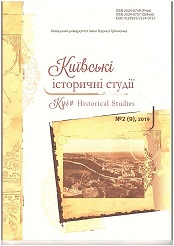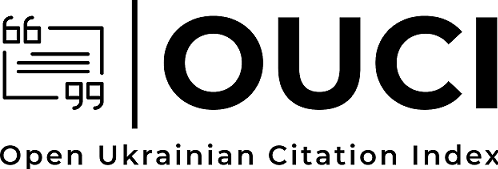CERTAIN ASPECTS OF THE IMPERIAL MEMORY POLICY TOWARDS THE DNIEPER UKRAINE AND THE CRIMEA IN THE 19TH — EARLY 20TH CENTURY
DOI:
https://doi.org/10.28925/2524-0757.2019.2.1Keywords:
historical memory, memory policy, memory sites, museums, Russian Empire, Dnieper UkraineAbstract
The research is devoted to the implementation of the imperial memory policy towards the Dnieper Ukraine and the Crimea in the 19th — early 20th century. Ukraine had been ruled by foreign states for centuries. Therefore, Ukrainian history has often been interpreted as dependent territory, ruled by the bigger neighbouring states. Russian and Polish historians of the 19th century included in their national historical narratives all lands, which were part of Russia or Poland respectively. The dynastic approach was proper for the historiography of the 19th century. “History of the Russian State” by Nikolay Karamzin is considered as an example of the dynastic approach in the 19th century Russian history where the idea of autocracy was proclaimed as a common good of the Russian Empire. Similar theses, in general, were typical for the 19th century and ended with the glorification of the monarchy and the proper ancestry. The purpose of the study is to identify and characterize the main tools and methods of conducting the Russian imperial memory policy on the creation of the geopolitical project of the Russian Orthodox World. The methodology of the study is based on the principles of historicism, systematic, scientific and interdisciplinary approach. The following general historical methods are used: historiographic analysis, historical-genetic, terminological analysis, comparative and typological methods. The author is adhered to the civilizational approach. The creation of a geopolitical project of the Russian Orthodox World is defined as strategic purpose of the policy which is implemented by means of forming a common identity on the imperial frontiers. The imperial memory policy has caused deep deformations in the collective consciousness of the Ukrainians.
Downloads
References
Vozzvanie komiteta o vosstanovlenii pamiatnikov Sevastopolskoi oborony [The Appeal of the Committee on the Restoration of Monuments of the Sevastopol Defense]. (1902). Izvestiia Tavricheskoi uchennoi arkhivnoi komissii, Simferopol, Tavricheskaia gubernskaia tipografiia [in Russian].
Haukhman, M. V. (2014). «Kozatska pamiat»: komemoratyvni praktyky chornosotentsiv Volyni na pochatku XX st. [Cossack Memory: Commemorative Practices of the Black Hundreds of Volyn in the Early 20th Century]. Naddniprianska Ukraina: istorychni protsesy, podii, postati [in Ukrainian].
Iversen, Yu. (1880). Medali vybityie v tsarstvovanie imperatora Aleksandra ІІ. SPb: Tipografiia akademii nauk [in Russian].
Isakova, Ye. V. (1991). Khramy-pamiatniki russkoi voienni doblesti. Moskva, Znanie [in Russian].
Shapoval, Yu. (Ed.). (2013). Kultura istorychnoi pamiati: yevropeiskyi ta ukrainskyi dosvid. Kyiv: IPIEND [in Ukrainian].
Lebedintsev, A. (1896). Russkie gosudari v Kieve (1706–1885). Kyiv: Tip.-lit. Vys. utv. T-va I.N. Nushnereva i KO [in Russian].
Lents, M. (1906). Bombardirovanie Odessy (16 aprelia 1854 g.). [Bombing of Odessa (April 16, 1854)]. Zapiski Imperatorskogo Odesskogo obshchestva istorii i drevnostei [in Russian].
Liperovskii, A. V. (1907). Gde pokhoroneny shvedskie voiny posle bitvy 27 iiunia 1709 goda? [Where are the Swedish Soldiers Buried after the Battle of June 27, 1709?]. Trudy Poltavskoi uchenoi arkhivnoi komissii [in Russian].
Murzakevich, N. (1896). Istoricheskie pesni kasaiushchiesia sobytii Novorossiiskogo kraia [Historical Songs Relating to the Events of the Novorossiisk Territory]. Zapiski Odesskogo obshchestva istorii i drevnostei [in Russian].
Pavlovskii, I. F. (1908). Bitva pod Poltavoi 27-go iyunia 1709 goda i yeio pamiatniki. Poltava: tipo-lit. I. A. Dokhmana [in Russian].
Pamyati Sevastopolskoi oborony [In Memory of Sevastopol Defense]. (1902). Otchet o deiatelnosti Vysochaishe utverzhdennogo pod predsedatelstvom Velikogo Kniazia Aleksandra Mikhailovicha Komiteta po vosstanovleniiu pamiatnikov Sevastopolskoi oborony. Izvestiia Tavricheskoi uchennoi arkhivnoi komissii [in Russian].
Parskii, D. P. (1902). Sevastopol i pamiatniki ego oborony. Odessa: Tipografiia Shtaba Odesskogo voennogo okruga [in Russian].
Pogodin, M. P. (1868). Polskii vopros. Sobranie rassuzhdenii, zapisok i zamechanii 1831–1867. Moskva: Tipografiia gazety «Russkii» [in Russian].
Romashkevich, A. D. (1905). Materialy k istorii Petrovskogo Poltavskogo kadetskogo korpusa 1904–1913 s 1-go oktiabria 1904 g. po 1-e oktiabria 1905 g. Poltava: Elektr. tipo-litograf. I. A. Dokhmana [in Russian].
Sbornik rukopisei predstavlennykh ego imperatorskomu vysochestvu gosudariu nasledniku tsesarevichu o Sevastopolskoi oborone sevastopoltsami. (1872). SPb.: Tipografiia A. Transhelia. [in Russian].
Published
How to Cite
Issue
Section
License
Copyright (c) 2019 Kyiv Historical Studies

This work is licensed under a Creative Commons Attribution-NonCommercial-ShareAlike 4.0 International License.
Authors who publish in this journal retain the right of authorship of the work and give to the journal right of first publication of this work under the conditions of Creative Commons: Attribution-NonCommercial-ShareAlike 4.0 International (CC BY-NC-SA 4.0), which allows others freely distribute the work published with reference to the authors of the original work and the first publication of this magazine.














